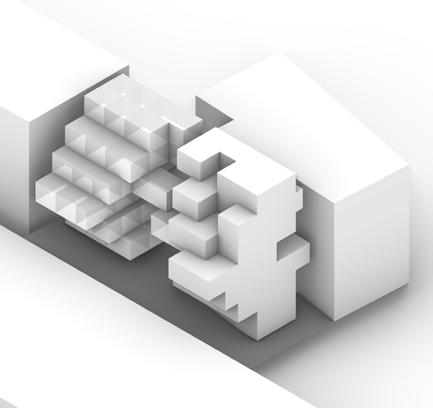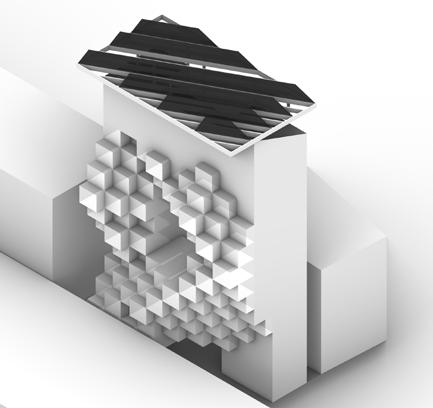



01. Valve Flow Dynamics
Timeline: Spring 2024; Location: Boston, MA; Course Tutor: Alexandru Vilcu, Christian Borger; Software used: Rhino, InDesign
This experimental project explores creating dynamic spaces that will float using brass floating valves as modular units. The design integrates these valves into architectural elements reconfigure based on valve movements. The interactive environment will transform in real time, enhancing user experience and catering to various activities. This innovative approach aims to blend mechanical ingenuity with architectural creativity, resulting in a trans-formative and engaging space.


02. Wonder POD
Modular tiny house the can create a social impact
Prellwitz Chilinski Associates (PCA)- Externship (2025-1 week)
Role: Design, 3d modeling, visualization
Software used: Rhinoceros 3D, Illustrator, Photoshop, InDesign
The Modular Floating Housing Unit is an adaptable and scalable living solution designed to fit seamlessly into diverse environments across the world, from water bodies to rugged terrains and urban settings. Rooted in the concept of fostering social spaces, the modular design enables multiple units to connect and create shared areas that encourage interaction and community engagement. The structure features an adaptable wall system that allows for climate-responsive insulation, enhancing energy efficiency in varying conditions.


Retractable

facade proportions with shading devices.
Vertical Spatial Relationships
Conditional Neighbor interaction zone
Wall Insulation Variation for different climatic condition

Sustain ably sourced tube/ barrel flotation system
Modular and adaptable structure
The exterior wall design features a middle hollow section that adapts to all climates, allowing flexibility in insulation choices. This adaptability enhances energy efficiency and occupant comfort throughout changing environmental conditions.
This compact living space is designed for efficiency, featuring a kitchenette, toilet under the bed, ample storage, and a fold able deck for flexible outdoor use. The layout maximizes functionality while ensuring convenience and adaptability.

This house is designed to stand anywhere, including on water. The diagram showcases the floating system concept, demonstrating how the structure stays stable and functional in different environments. A modular grid system provides support and balance, while an anchor system stabilizes the house, keeping it secure on water.

When two decks come together, they create a shared community space that encourages social interaction, connectivity, and engagement.
03. Urban Elevate
Elevating Urban Living Through Knowledge and Community Program: Library, Housing, and Community Space
Timeline: Fall 2024; Location: 340 Summer St, Boston, MA; Course Tutor: Erik Schiller; Software used: Rhinoceros 3D, Auto-desk flow, Illustrator, Photoshop, Grasshopper, InDesign
Urban Elevate is a mixed-use vertical development combining a public library on the lower levels, modern housing on the upper floors, and a central community space. The design fosters connection and engagement while ensuring sustainability with a modular facade that optimizes natural light and ventilation. This project redefines urban living by blending learning, community, and residential comfort in one harmonious structure.


The site sits 24 feet below Summer Street, creating a unique opportunity for vertical integration. The design establishes a seamless connection between Summer Street and West Service Road, using the lower levels to house the public library while creating a visually and physically accessible pathway through the site. This thoughtful approach enhances accessibility, fosters interaction, and ensures the structure blends harmoniously with the urban fabric.



























The design explores massing strategies to optimize sunlight penetration and create a visually connected central atrium. The shifting of floors generates terraces, fostering social interaction among building users and enhancing connections with the surroundings.
The design focuses on accessibility by incorporating ramps and interactive spaces for users of all abilities. It ensures universal design principles through features like handrails, adequate clearances, and multi-level interaction points. The layout promotes inclusivity, enabling seamless mobility and fostering community engagement.

Solid, continuous glass facades can pose a significant risk to birds due to reflections that obscure the barrier. One of the primary aims of this project was to minimize the continuous use of glass surfaces, ensuring a more bird-friendly and environmentally considerate design.





04. Ayurvedic Wellness Resort
Location: Cox’s’ Bazaar, Bangladesh; Project Type: Health Resort; Principal Architect: Nabil Sahidi(Onno Architects); Role: Design, 3d modeling, visualization, architectural drawings, construction drawings; Software used: Autocad-SketchupRhino- D5- Lumion- Photoshop- Project management
The Ayurvedic Wellness Centre in Cox’s Bazar, Bangladesh, is designed to be a serene sanctuary promoting holistic well being through traditional Ayurvedic principles. Nestled near the Bay of Bengal, the center blends seamlessly with its natural surroundings, offering breathtaking views of the sea and mountains. By utilizing rammed earth and locally sourced materials, the center not only fosters sustainability but also creates a deep connection to the cultural and environmental context of Cox’s Bazaar.













N Service block construction drawing
The service block is designed for the South Asian context, using brick jali for ventilation and filtered light, ideal for the warm climate. Its layout ensures efficiency, with local materials enhancing sustainability and cultural relevance. The design blends modern functionality with traditional South Asian principles.








05. Baad Ijtema multipurpose use of ijtema maidan
B Arch Academic project, Course: Advanced Studies Studio II- Thesis Project
Timeline: 2019, Location: Dhaka, Bangladesh
Course Teacher: Dr. Nandini Awal, Mozzafaruddin Chowdhury
Software used: Autocad- Sketchup- Rhino- VrayPhotoshop
Within the bustle of the overpopulated metropolis, Dhaka prominently lacks adequate space which generates and celebrates public activity. Uttara and adjacent Tongi areas form an important urban center of North Dhaka. The area is connected with the rest of the country by the vast and complex river system of the delta via Turag River. Ijtema maidan – a place hosting second large Islamic congregation after Hajj– is a massive 216 acres area of land adjacent to the riverbank of Turag. The place remains active during this annual event which is hardly 30 days in a year. For the rest of the 335 days it remains unused. This project rethinks Ijtema maidan as a year-round multipurpose public space while fulfilling its periodic function during Ijtema time.

No connection with Surrounding
Hardly use for one month in a year




Current temporary shade during ijtema
Current temporary amenities during ijtema
During regular days, an empty space of 216 acres with thousand of possibilities


Site surrounding zoning





15’

Proposed temporary shade durring ijtema






Strategically placed trees not only act as barriers to sound, noise and pollution. But they can also help the growth of the ecological landscape and help revive riverine ecosystems.






































